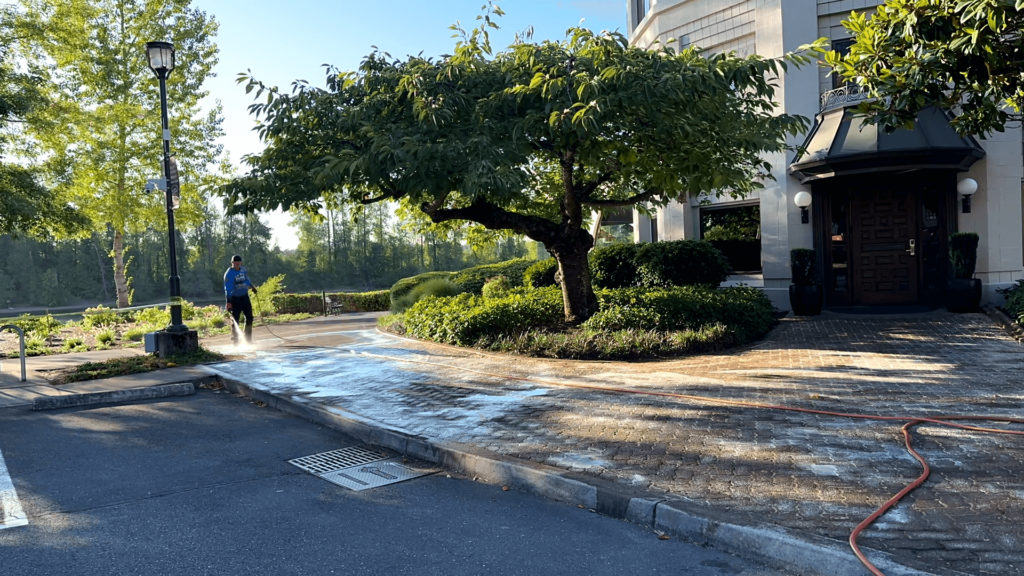Key Takeaways
- Paver sealing protects surfaces from weather damage, stains, and deterioration
- Proper sanding between pavers prevents weed growth and shifting
- Routine sealing enhances curb appeal and property value
- Oregon homeowners benefit from sealing due to the region’s wet climate
- Professional sealing services ensure longevity and safety
Pavers are a beautiful addition to any property, but Oregon’s climate poses a constant challenge. Between rain, snow, sun exposure, and foot traffic, unsealed pavers can fade, crack, or shift over time. That’s where sealing and sanding come in.
Sealing creates a protective barrier that defends against moisture, stains, and UV damage. Meanwhile, sanding fills the joints between pavers to stabilize the surface and prevent weed growth. Together, these two services help extend the lifespan and preserve the appearance of your hardscaped areas.
How Oregon Weather Impacts Pavers
Living in the Pacific Northwest means contending with:
- Frequent Rainfall – Trapped moisture can lead to erosion, algae, and mildew.
- Freeze-Thaw Cycles – Water that seeps into unsealed pavers can freeze and expand, causing cracks.
- UV Exposure – Prolonged sun exposure fades color and weakens surfaces.
Without proper protection, pavers can degrade quickly in these conditions. Sealing combats these elements by forming a water-resistant, UV-blocking layer.
Top Benefits of Sealing and Sanding Your Pavers
- Boosts Curb Appeal
Sealed pavers look cleaner, bolder, and more vibrant. Whether it’s your driveway, patio, or walkway, a polished appearance immediately elevates your property’s aesthetic. - Prevents Weed Growth and Insect Activity
Polymeric sand hardens between pavers, filling the gaps where weeds and ants tend to take over. This makes outdoor spaces easier to maintain. - Reduces Long-Term Maintenance
Stains from spills, dirt, and algae are easier to clean on sealed surfaces. This reduces the frequency of deep cleaning or replacement. - Improves Structural Integrity
Proper sanding prevents pavers from shifting or sinking, especially in high-traffic zones. This helps avoid tripping hazards and uneven surfaces. - Increases Durability and Longevity
Sealed pavers resist erosion and deterioration, keeping your investment in great condition for years.
Common Misconceptions About Paver Sealing
Many homeowners mistakenly believe that sealing is purely cosmetic. In reality, it plays a functional role in protecting your surfaces. Others think sealing needs to be done only once, but reapplication every few years is often necessary depending on wear and environmental exposure.
Additionally, some assume sealing makes surfaces slippery. In truth, quality sealants are formulated with anti-slip properties that maintain traction while enhancing appearance.
Why Sanding Matters as Much as Sealing
While sealing gets the spotlight, sanding is just as critical. Without fresh joint sand, your pavers are vulnerable to shifting, weed intrusion, and water damage. Polymeric sand, in particular, offers long-lasting joint stability by hardening when activated with water.
It’s this combination of sealing and sanding that ensures a durable, low-maintenance outdoor surface.
Why Hiring Professionals Is Worth It
While DIY kits are available, improper application can lead to uneven finishes, sealant haze, or worse—trapped moisture that accelerates damage.
Professionals like Peak Pressure Washing have the tools, training, and surface prep techniques to ensure proper cleaning, sanding, and sealing. The result? A clean, protected, and professionally finished space that stands up to Oregon’s weather.
Advantages of professional paver sealing and sanding include:
- Thorough power washing before sealing
- Even application using commercial-grade tools
- Proper curing and dry times observed
- Use of high-quality sealants suitable for Oregon conditions
Signs It’s Time to Reseal Your Pavers
- Faded or dull appearance
- Growth of moss, mildew, or weeds between joints
- Surface feels rough, dry, or overly absorbent
- Visible shifting or widening between pavers
Most paver surfaces should be resealed every 2–3 years. If your hardscape is exposed to high traffic or harsh elements, more frequent maintenance may be necessary.
Frequently Asked Questions
How long does sealed paver protection last?
Depending on climate and usage, expect the sealant to last 2–3 years before needing a reapplication.
Does sanding need to be done every time you reseal?
Not always. If joints remain full and stable, sanding may not be required during every reseal. However, if gaps appear, re-sanding is essential.
Will sealing make my pavers look shiny?
That depends on the type of sealant. Some finishes offer a glossy look, while others provide a more natural matte appearance.
Can sealing help with slippery surfaces?
Yes. Certain sealants contain additives that enhance traction, making sealed surfaces safe even when wet.
Maintain Beautiful Outdoor Spaces With Help From Professionals
Proper paver sealing and sanding are essential to keeping your outdoor surfaces safe, functional, and beautiful. Instead of waiting for fading, shifting, or weeds to take over, proactive care ensures your hardscape stays in peak condition.
Peak Pressure Washing offers expert paver sealing and sanding services tailored to Oregon homes. With the right maintenance plan, your pavers can continue adding curb appeal and value for years to come.

